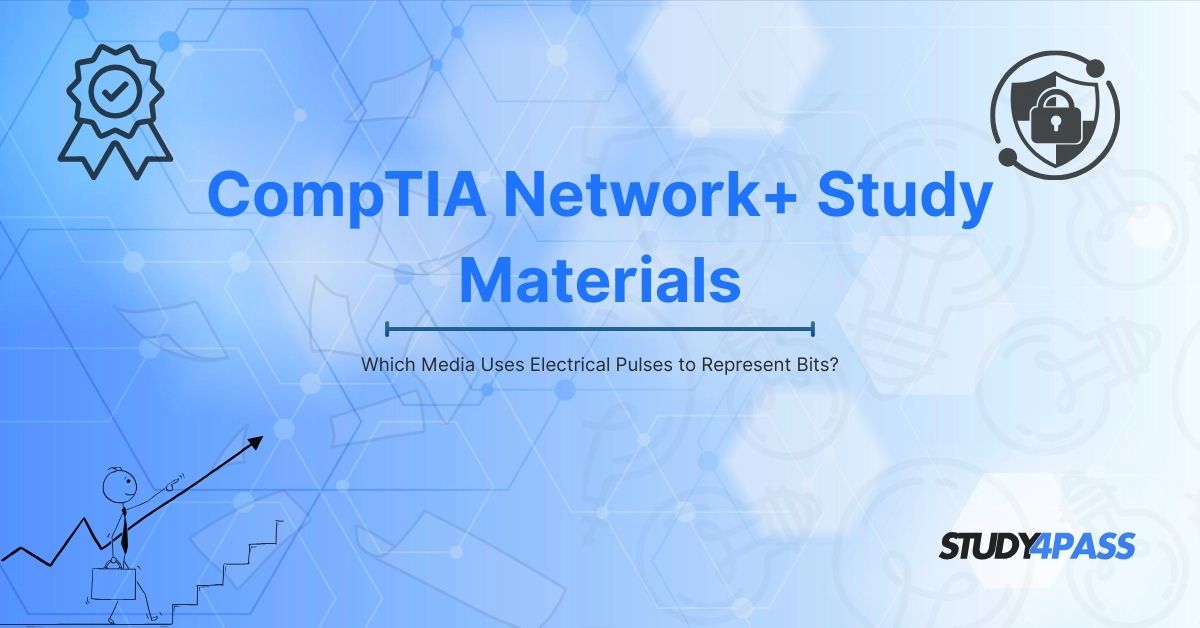In the electrifying world of networking, understanding how data travels is a spark that ignites success. For those pursuing the CompTIA Network+ Certification, whether it’s the current N10-008 or the upcoming N10-009, grasping the physical media that carries bits is fundamental. A key question lights the way: Which media uses electrical pulses to represent bits? This article unveils the answer copper-based media and illuminates how Network+ Certification Questions by Study4Pass powers you to master this concept, outshine peers in certifications like Cisco CCNA (200-301) or CompTIA A+ (220-1101), and claim your CompTIA Network+ Certification.
Introduction to CompTIA Network+ Certification: The Spark of Connectivity
The CompTIA Network+ Certification is your gateway to a thriving networking career, bridging foundational IT skills from CompTIA A+ (220-1101) to advanced routing in Cisco CCNA (200-301). With N10-008 active in April 2025 and N10-009 on the horizon (mid-2025), it’s a dynamic credential testing media, protocols, and troubleshooting. Physical media the conduits of data spark curiosity and exam questions alike, and Study4Pass fuels your prep with top-tier study materials and exam prep practice test.
CompTIA Network+ Certification: An Overview
The CompTIA Network+ Certification validates skills in designing, configuring, and managing networks. The N10-008 exam (90 questions, 90 minutes) covers five domains, while N10-009 will evolve to include cloud and virtualization trends. Both emphasize physical layer media a stepping stone from CompTIA A+ (220-1101)’s hardware focus and a complement to Cisco CCNA (200-301)’s switching depth. Study4Pass ensures you’re wired for success.
Decoding Bits in the Physical Realm
Bits 1s and 0s are the language of networks, but how do they travel? At the Physical Layer (Layer 1) of the OSI model, media translate these bits into signals:
- Electrical Pulses: Voltage changes over copper.
- Light Pulses: Fiber optic flashes.
- Radio Waves: Wireless signals.
The CompTIA Network+ Certification tests this translation, and Study4Pass lights the path.
The Answer Unveiled: Copper-Based Media
Copper-based media uses electrical pulses to represent bits. This includes twisted pair (e.g., Cat6) and coaxial cables, where voltage shifts high for 1, low for 0 encode data. Unlike fiber’s light or wireless’s waves, copper’s electrical nature powers networks from homes to enterprises.
- Example: A Cat5e cable sends a 1 Gbps signal via voltage swings.
Study4Pass sparks this understanding for N10-008 and N10-009.
Copper in Action: A Closer Look
Copper media thrives on electrical pulses:
- Twisted Pair: Pairs of wires (e.g., UTP) twist to reduce interference, pulsing data at speeds up to 10 Gbps (Cat6a).
- Coaxial: A central conductor pulses signals, shielded for reliability (e.g., RG-6 for cable internet).
- Mechanics: Voltage shifts (e.g., +5V for 1, 0V for 0) encode bits, interpreted by NICs.
From CompTIA A+ (220-1101)’s cabling basics to Cisco CCNA (200-301)’s LANs, copper is ubiquitous. Study4Pass wires you for mastery.
Network+ Certification Lens: Media Mastery
Media types shine in CompTIA Network+ Certification domains:
- Networking Concepts (23%): Copper vs. fiber vs. wireless.
- Infrastructure (18%): Cabling standards (e.g., TIA/EIA-568-B).
- Troubleshooting (24%): Diagnosing copper issues.
Study4Pass powers up with:
- Guides: Copper media details for N10-008 and N10-009.
- Practice: “Which media uses electrical pulses?”
- Exam Prep Practice Tests: Exam-ready questions.
The Pulse in Practice
Copper’s electrical pulses drive real-world networks:
- Office LANs: Cat6 cables connect PCs to switches.
- Home Broadband: Coaxial links modems to ISPs.
- Troubleshooting: A frayed UTP cable disrupts pulses, a fixable N10-008 scenario.
These applications bridge CompTIA A+ (220-1101)’s hardware to Cisco CCNA (200-301)’s configs, and Study4Pass connects the dots.
Beyond the Pulse: Contrasting Media
| Media Type | Signal | Use Case |
| Copper | Electrical Pulses | LANs, broadband |
| Fiber Optic | Light Pulses | Long-distance, high-speed |
| Wireless | Radio Waves | Mobile, Wi-Fi |
Copper’s affordability contrasts fiber’s speed and wireless’s flexibility key N10-009 distinctions Study4Pass clarifies.
Gearing Up for Network+: The Pulse Strategy
Acing CompTIA Network+ Certification requires a charge:
- Master Media: Study copper’s electrical role.
- Use Study4Pass: Tap N10-008 and N10-009 materials.
- Practice: Test copper configs in simulators.
- Time It: Aim for 1 minute per question.
- Review: Use Study4Pass analytics.
From CompTIA A+ (220-1101) to Cisco CCNA (200-301), Study4Pass energizes your path.
The Final Current
Copper-based media uses electrical pulses to represent bits, a vital CompTIA Network+ Certification concept for N10-008 and N10-009. Its role in LANs and beyond powers connectivity, and Study4Pass electrifies your prep for success.
Study4Pass delivers:
- Precision: Targets N10-008 and N10-009 media focus.
- Realism: Exam Prep Practice Tests mirror exam challenges.
- Efficiency: Boosts prep, outpacing Cisco CCNA (200-301) peers.
For a small cost, you’re unlocking a Network+ worth $60,000-$90,000 annually.
You’re the current of tomorrow’s networks! With Study4Pass, CompTIA Network+ Certification is yours to claim. Power up, prepare thoroughly, and shine beyond CompTIA A+ (220-1101) or Cisco CCNA (200-301). Your future buzzes ignite it now!
Special Discount: Offer Valid For Limited Time “CompTIA Network+ Exam Prep Practice Test”
Actual Questions from CompTIA Network+ Certification Exam Prep Practice Tests
Which media uses electrical pulses to represent bits?
A) Fiber optic
B) Copper-based
C) Wireless
D) Infrared
What’s an example of copper media?
A) Single-mode fiber
B) Cat6 twisted pair
C) Wi-Fi antenna
D) Multimode fiber
How does copper media differ from fiber optic?
A) Uses light pulses
B) Uses electrical pulses
C) Higher cost
D) Longer range
What’s a common use of coaxial copper media?
A) Wireless LANs
B) Cable broadband
C) Long-haul fiber links
D) Satellite comms
What disrupts copper pulses?
A) EMI from nearby cables
B) Light interference
C) Radio frequency overlap
D) Glass attenuation


